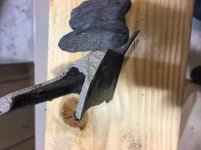dgfoster
Diamond
- Joined
- Jun 14, 2008
- Location
- Bellingham, WA
Interesting story on the inclusion. Here is what I have gleaned on the subject:
That hard spot probably was not the remnants of a hard bolt. I say that for two reasons. First, steel will dissolve in molten iron. In fact there are folks who advocate routinely adding steel as a cheap way to augment your feedstock supply. And the commercial foundry I use commonly adds non-lead-containing steel to their mix if they need to alter their alloy to achieve a given spec. When thrown into molten cast iron, that steel dissolves below usual steel melting temps. So, if a bolt got into the furnace crucible, why didn’t it dissolve? Secondly, a previously hard bolt that somehow did not fully dissolve would be softened by soaking in 2500F molten iron.
More likely that was a piece of slag. Here is a thread on inclusions:
http://www.practicalmachinist.com/vb/general/hard-spots-deep-inside-cast-iron-307327/
Another possible cause for a hard spot is localized chilling of molten iron causing formation of white iron. That is less likely to occur as a little localized hard spot but more as a general area of hardness. It is common to form white iron when mass producing items used mainly as weights like sash weights for old style windows. They were cast in huge numbers and shaken out of the sand into cold air as soon as the iron had solidified. Rapid chilling resulted in a piece of iron that is extremely hard. I have tried to bore such a weight----once!
Carbide inclusion could occur from contaminated feed stock.
Like so many things, the quality of castings produced by a foundry depends in large measure to the attention paid to all aspects of the melt and pour. Some folks are very careful, some not so much.
Denis
This morning I was doing a test cast of a pattern for a cored lightweight prism. Since this was just a rough test of a pattern and core and I was curious to see if the pattern filled properly, I shook the casting out of the sand only 5 minutes after it was cast. As I shook it out it was still glowing! The iron had filled the sand mold fine but I was using a hammer to knock off the gates and sprue and the casting itself broke unexpectedly. No big deal as it was not going to be kept but it was a surprise. Examination of the break revealed the cause. Rapid cooling had caused it to crystallize as white iron instead of grey cast iron. Here iis a photo of the broken prisms alongside a broken piece of the identical alloy but cast another time and cooled normally. The prism is on the bottom and the difference in grain structure is quite striking. The prism piece is extremely hard and impossible to drill with a good HSS drill.



